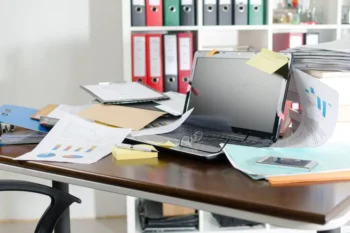A clutter-free office isn’t just about aesthetics; it’s essential for productivity, efficiency, and overall well-being in the workplace. As an office manager, maintaining an organized and tidy environment can significantly impact your team’s performance and morale. Here’s how you can effectively keep your office clutter-free and create a more productive workspace.
Implement a Clear Organizational System
Establish a clear organizational system for your office. This includes everything from filing cabinets and desk drawers to digital files. Categorize items logically and ensure that every piece of equipment or document has a designated place.
For example, set up labeled folders for physical documents and create a digital filing system with clear folder names and subfolders. Ensure that everyone in the office is aware of and follows these organizational standards to maintain consistency.
Encourage a Clean Desk Policy
A clean desk policy promotes a clutter-free workspace and helps employees focus on their tasks. Encourage team members to keep their desks tidy by removing unnecessary items and organizing essential supplies.
You might implement rules like:
- End-of-Day Clean-Up: Require team members to tidy their desks at the end of each workday.
- Minimalist Desk Setup: Limit the number of items allowed on desks to essentials only.
- Personal Responsibility: Encourage employees to take ownership of their workspace and maintain its cleanliness.
Use Storage Solutions Wisely
Utilize storage solutions effectively to keep your office organized. Invest in shelving, filing cabinets, and drawer organizers to store documents, office supplies, and equipment. Make sure that storage solutions are easily accessible and designed to fit your office layout.
For instance, use vertical storage to save desk space, and incorporate drawer dividers to keep small items like pens, paper clips, and sticky notes neatly organized. Label storage containers to make it easy for everyone to find and return items.
Implement a Paper Management System
Paper clutter can quickly accumulate and overwhelm your workspace. Implement a paper management system to handle incoming documents and keep paperwork organized.
Consider the following strategies:
- Digital Transformation: Move towards a paperless office by digitizing documents and using electronic signatures. Utilize cloud storage for easy access and sharing.
- Filing System: Set up a filing system for necessary physical documents, with clear categories and labels.
- Shredding Policy: Regularly shred documents that are no longer needed to prevent paper buildup and ensure confidentiality.
Conduct Regular Clean-Up Sessions
Schedule regular clean-up sessions to maintain a clutter-free environment. These sessions can be weekly or monthly, depending on the office’s needs. Use this time to declutter common areas, review organizational systems, and address any accumulated mess.
Encourage team members to participate in these clean-up sessions and provide guidance on how to declutter their workspaces effectively. Make it a collaborative effort to ensure that everyone is involved and committed to maintaining cleanliness.
Set Up Effective Systems for Incoming Items
Implement systems for managing incoming items, such as mail, packages, and office supplies. Designate specific areas for sorting and processing these items to prevent them from piling up on desks or common areas.
For example, set up a mailroom or sorting station where incoming mail and packages can be processed and distributed efficiently. Implement an inventory management system to track office supplies and reorder items before they run out.
Foster a Culture of Organization
Promote a culture of organization and cleanliness within your office. Lead by example and encourage team members to adopt and maintain organizational habits. Recognize and reward individuals who consistently contribute to a tidy and well-organized workspace.
Consider organizing workshops or training sessions on best practices for office organization and time management. Provide resources and tools to help employees stay organized and maintain a clutter-free environment.
Address Clutter Issues Promptly
When clutter issues arise, address them promptly to prevent them from escalating. Identify the root causes of clutter and implement solutions to address them effectively. Regularly review and adjust organizational systems as needed to accommodate changes in the office.
If you notice that certain areas or processes are consistently causing clutter, assess the situation and make necessary adjustments. For instance, if paperwork is piling up due to a lack of filing space, consider expanding your filing system or increasing digital document usage.
Keeping the office clutter-free is crucial for maintaining a productive and pleasant work environment. By implementing a clear organizational system, encouraging a clean desk policy, using storage solutions wisely, managing paper effectively, conducting regular clean-up sessions, setting up systems for incoming items, fostering a culture of organization, and addressing clutter issues promptly, you can ensure that your office remains tidy and efficient. A clutter-free workspace not only enhances productivity but also contributes to a more positive and focused atmosphere for your team.
